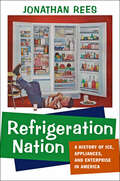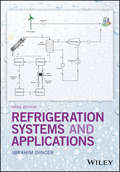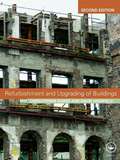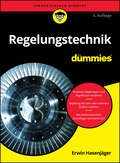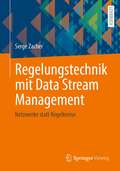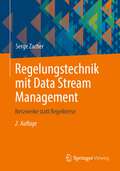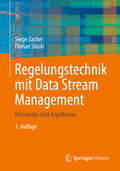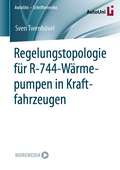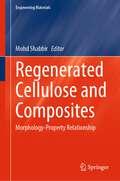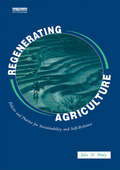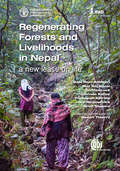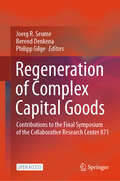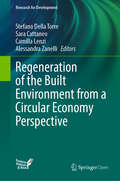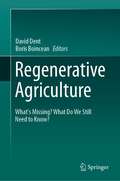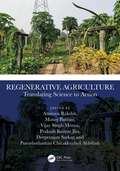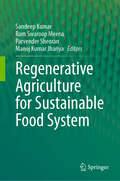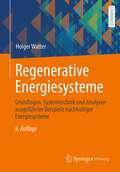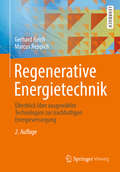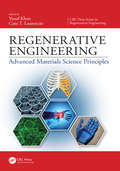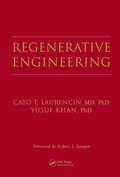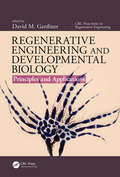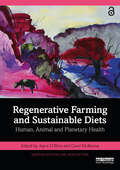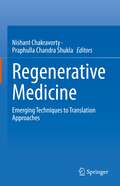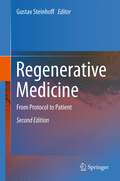- Table View
- List View
Refrigeration Nation: A History of Ice, Appliances, and Enterprise in America (Studies in Industry and Society)
by Jonathan ReesHow we keep food cold while the house stays warm.Only when the power goes off and food spoils do we truly appreciate how much we rely on refrigerators and freezers. In Refrigeration Nation, Jonathan Rees explores the innovative methods and gadgets that Americans have invented to keep perishable food cold—from cutting river and lake ice and shipping it to consumers for use in their iceboxes to the development of electrically powered equipment that ushered in a new age of convenience and health.As much a history of successful business practices as a history of technology, this book illustrates how refrigeration has changed the everyday lives of Americans and why it remains so important today. Beginning with the natural ice industry in 1806, Rees considers a variety of factors that drove the industry, including the point and product of consumption, issues of transportation, and technological advances. Rees also shows that how we obtain and preserve perishable food is related to our changing relationship with the natural world.
Refrigeration Systems and Applications
by Ibrahim DincerThe definitive text/reference for students, researchers and practicing engineers This book provides comprehensive coverage on refrigeration systems and applications, ranging from the fundamental principles of thermodynamics to food cooling applications for a wide range of sectoral utilizations. Energy and exergy analyses as well as performance assessments through energy and exergy efficiencies and energetic and exergetic coefficients of performance are explored, and numerous analysis techniques, models, correlations and procedures are introduced with examples and case studies. There are specific sections allocated to environmental impact assessment and sustainable development studies. Also featured are discussions of important recent developments in the field, including those stemming from the author’s pioneering research. Refrigeration is a uniquely positioned multi-disciplinary field encompassing mechanical, chemical, industrial and food engineering, as well as chemistry. Its wide-ranging applications mean that the industry plays a key role in national and international economies. And it continues to be an area of active research, much of it focusing on making the technology as environmentally friendly and sustainable as possible without compromising cost efficiency and effectiveness. This substantially updated and revised edition of the classic text/reference now features two new chapters devoted to renewable-energy-based integrated refrigeration systems and environmental impact/sustainability assessment. All examples and chapter-end problems have been updated as have conversion factors and the thermophysical properties of an array of materials. Provides a solid foundation in the fundamental principles and the practical applications of refrigeration technologies Examines fundamental aspects of thermodynamics, refrigerants, as well as energy and exergy analyses and energy and exergy based performance assessment criteria and approaches Introduces environmental impact assessment methods and sustainability evaluation of refrigeration systems and applications Covers basic and advanced (and hence integrated) refrigeration cycles and systems, as well as a range of novel applications Discusses crucial industrial, technical and operational problems, as well as new performance improvement techniques and tools for better design and analysis Features clear explanations, numerous chapter-end problems and worked-out examples Refrigeration Systems and Applications, Third Edition is an indispensable working resource for researchers and practitioners in the areas of Refrigeration and Air Conditioning. It is also an ideal textbook for graduate and senior undergraduate students in mechanical, chemical, biochemical, industrial and food engineering disciplines.
Refurbishment and Upgrading of Buildings
by David Highfield Christopher GorseA detailed guide to the technical aspects of refurbishing and upgrading buildings, this book provides solutions to a range of problems, challenges and issues and is essential reading for all students studying building refurbishment at all levels. Includes: existing floor and wall strengthening facade retention introduction of new floors timber decay problems fire-resistance prevention of moisture and damp upgrading thermal and acoustic performance. This new edition has been fully updated to include new technological information, and covers new areas such as stonework restoration and repair, upgrading of c1960 framed buildings, refurbishment logistics and case-studies.
Regelungstechnik für Dummies (Für Dummies)
by Erwin HasenjägerAuch Maschinen haben ihre Regeln Auch wenn der Name sehr geordnet klingt, ist Regelungstechnik bisweilen komplex. Damit Sie dennoch damit zurechtkommen, erklärt Erwin Hasenjäger Schritt für Schritt und mit zahlreichen Beispielen, was Sie über dieses Thema unbedingt wissen sollten. Sie erfahren, welche Reglertypen es gibt, weshalb Simulationen so wichtig sind, was es mit Schwingungen sowie Dynamik auf sich hat und vieles mehr. Natürlich kommen dabei auch die mathematischen Grundlagen und die passende Software nicht zu kurz. So ist Regelungstechnik für Dummies der perfekte Einstieg in dieses anspruchsvolle Thema. Sie erfahren Wie Sie digitale und andere Besonderheiten berücksichtigen Wie Sie die richtigen Reglereinstellungen wählen Was SISO und MIMO bedeuten Wie Sie Prozesse geschickt optimieren können
Regelungstechnik mit Data Stream Management: Netzwerke statt Regelkreise
by Serge ZacherEin Lehrbuch zu neuen Konzepten der Regelungstechnik Bus-Approach und Antisystem-Approach (ASA), die bereits bei mehreren Projekten implementiert wurden.Die seit Jahrzehnten etablierten Wirkungspläne von Regelkreisen sind im Buch durch bus-ähnliche Netzwerke ersetzt. Prinzipiell neue regelungstechnische Bausteine, wie ASA-Regler und so genannte Data Stream Manager (DSM), werden entwickelt. Es sind verschiedene DSM-Typen beschrieben und an Beispielen verdeutlicht (Router, Tuner, Koordinator usw.).Die theoretischen Grundlagen sind im Buch mit Übungsaufgaben und MATLAB®-Simulationen begleitet. Bei der Gestaltung von Lösungswegen sind auch die Bedürfnisse von dualen und berufsintegrierten Bachelor- und Master-Studiengängen berücksichtigt.
Regelungstechnik mit Data Stream Management: Netzwerke statt Regelkreise
by Serge ZacherEin Lehrbuch zu neuen Konzepten der Regelungstechnik Bus-Approach und Antisystem-Approach (ASA), die bereits bei mehreren Projekten implementiert wurden.Die seit Jahrzehnten etablierten Wirkungspläne von Regelkreisen sind im Buch durch bus-ähnliche Netzwerke ersetzt. Prinzipiell neue regelungstechnische Bausteine, wie ASA-Regler und so genannte Data Stream Manager (DSM), werden entwickelt. Es sind verschiedene DSM-Typen beschrieben und an Beispielen verdeutlicht (Router, Tuner, Koordinator usw.).Die theoretischen Grundlagen sind im Buch mit Übungsaufgaben und MATLAB®-Simulationen begleitet. Bei der Gestaltung von Lösungswegen sind auch die Bedürfnisse von dualen und berufsintegrierten Bachelor- und Master-Studiengängen berücksichtigt.
Regelungstechnik mit Data Stream Management: Netzwerke statt Regelkreise
by Serge Zacher Florian StöcklEin Lehrbuch zu neuen Konzepten der Regelungstechnik Bus-Approach und Antisystem-Approach (ASA), die bereits bei mehreren Projekten implementiert wurden.Die seit Jahrzehnten etablierten Wirkungspläne von Regelkreisen sind im Buch durch bus-ähnliche Netzwerke ersetzt. Prinzipiell neue regelungstechnische Bausteine, wie ASA-Regler und so genannte Data Stream Manager (DSM), werden entwickelt. Es sind verschiedene DSM-Typen beschrieben und an Beispielen verdeutlicht (Router, Tuner, Koordinator usw.).Die theoretischen Grundlagen sind im Buch mit Übungsaufgaben und MATLAB®-Simulationen begleitet. Bei der Gestaltung von Lösungswegen sind auch die Bedürfnisse von dualen und berufsintegrierten Bachelor- und Master-Studiengängen berücksichtigt.
Regelungstopologie für R-744-Wärmepumpen in Kraftfahrzeugen (AutoUni – Schriftenreihe #155)
by Sven TwenhövelDas Buch bietet eine Einführung in die Regelung von Kaltdampfprozessen am Beispiel von Kraftfahrzeugen. Das hergeleitete, generische Regelungskonzept kann auf eine große gesamte Klasse von Regelungsproblemen in Kältemittelkreislaufsystemen angewendet werden. Neben einer ausführlichen Streckenanalyse wird insbesondere Wert auf die Wiederverwendbarkeit und universelle Anwendung der erarbeiteten Regelkreise gelegt.
Regenerated Cellulose and Composites: Morphology-Property Relationship (Engineering Materials)
by Mohd ShabbirThis book highlights the morphology-property relationship of regenerated cellulose materials and composites, as morphology of materials is the key feature and corresponds to associated applications of/to the materials. It is highly essential to assimilate the literature on morphology-property relationship of cellulose materials. Being the most abundant natural polymer on earth and gateway to large number of applications, cellulose is expected to be researched for higher efficiencies. Various books and research articles have targeted the specific morphologies, the respective characteristics and application areas. This book presents literature on morphology-property relationship of cellulose materials and provides a direction to this relationship.
Regenerating Agriculture: An Alternative Strategy for Growth
by Jules N. PrettyFor the past 50 years, the main goal of agriculture has been to increase production at any price, using high amounts of fertilizers and pesticides and intensive industrial methods. This has caused damage to the environment and widespread rural depopulation. This study shows that there is a viable alternative - a form of agriculture which conserves resources, maintains rural employment and minimizes the external costs, without loss of productivity. Using case studies from industrialized and developing countries, the author describes the new technical, institutional and policy options available.
Regenerating Forests and Livelihoods in Nepal: A new lease on life
by Bala Ram Adhikari Nav Raj Baral Jim Hancock Govinda Kafley Pashupathi Koirala Jaap Reijmerinck Brett ShapiroRegenerating Forests and Livelihoods in Nepal: A New Lease on Life documents the success story of an innovative rural development programme in the Himalayan foothills, Nepal. The project has made a real difference by transforming increasingly degraded land, where farmers carved out a meagre existence, into a fertile and prosperous zone where they could thrive. Project activities included bringing in effective cultivation techniques to protect the environment and introducing new local crops and goats, as well as promoting entrepreneurial spirit. Every intervention was carefully selected and conducted to mitigate climate change as well as to help farmers become more resilient to its effects. The ingredients of the project's success, from both the technical and human perspectives, are presented in this book, demonstrating people's commitment in a country prone to natural disasters and earthquakes.
Regenerating Forests and Livelihoods in Nepal
by Benoît ThierryRegenerating Forests and Livelihoods in Nepal: A New Lease on Life documents the success story of an innovative rural development programme in the Himalayan foothills, Nepal. The project has made a real difference by transforming increasingly degraded land, where farmers carved out a meagre existence, into a fertile and prosperous zone where they could thrive. Project activities included bringing in effective cultivation techniques to protect the environment and introducing new local crops and goats, as well as promoting entrepreneurial spirit. Every intervention was carefully selected and conducted to mitigate climate change as well as to help farmers become more resilient to its effects. The ingredients of the project's success, from both the technical and human perspectives, are presented in this book, demonstrating people's commitment in a country prone to natural disasters and earthquakes.
Regeneration of Complex Capital Goods: Contributions to the Final Symposium of the Collaborative Research Center 871
by Berend Denkena Joerg R. Seume Philipp GilgeThis open access book compiles the groundbreaking research conducted by the Collaborative Research Center (CRC) 871, centered around the "Regeneration of Complex Capital Goods." This comprehensive work unveils an array of innovative methods developed through CRC 871, designed to revitalize and enhance the functional attributes of these critical assets. From non-destructive characterization of heavily stressed turbine components to the dynamic behavior of regenerated structural elements, each chapter offers a meticulous exploration of diverse facets in the field. The book also addresses the crucial consideration of variability in repair processes and material properties, as well as the comprehensive control of regeneration processes. With insights into simulation-based process design, fast measurement techniques, and resilience-based decision criteria, this volume provides a comprehensive view of the cutting-edge approaches employed. Moreover, readers will find a detailed process chain for condition-based regeneration, offering a practical framework for implementation. Finally, the book sheds light on the importance of targeted public relations in disseminating the invaluable research carried out by Collaborative Research Center 871. This extensive compilation not only showcases the scientific rigor behind maintaining complex capital goods but also demonstrates the collaborative efforts that brought together experts from various fields to push the boundaries of regeneration technology.
Regeneration of the Built Environment from a Circular Economy Perspective (Research for Development)
by Stefano Della Torre Sara Cattaneo Camilla Lenzi Alessandra ZanelliThis open access book explores the strategic importance and advantages of adopting multidisciplinary and multiscalar approaches of inquiry and intervention with respect to the built environment, based on principles of sustainability and circular economy strategies. A series of key challenges are considered in depth from a multidisciplinary perspective, spanning engineering, architecture, and regional and urban economics. These challenges include strategies to relaunch socioeconomic development through regenerative processes, the regeneration of urban spaces from the perspective of resilience, the development and deployment of innovative products and processes in the construction sector in order to comply more fully with the principles of sustainability and circularity, and the development of multiscale approaches to enhance the performance of both the existing building stock and new buildings. The book offers a rich selection of conceptual, empirical, methodological, technical, and case study/project-based research. It will be of value for all who have an interest in regeneration of the built environment from a circular economy perspective.
Regenerative Agriculture: What’s Missing? What Do We Still Need to Know?
by David Dent Boris BoinceanThe food system is our last coal-fired power station, our last diesel engine. This book is a trans-disciplinary approach to what needs to be done to make our food system sustainable and to regenerate soil and water resources, habitat, economy and society. The book brings back classical principles of agronomy and integrates economic, agro-ecological and social perspectives, drawing on a wealth of expertise on the political economy of the food system, Conservation Agriculture, and long-term field experiments. Regenerative agriculture builds on known knowns – like crop rotation, water and nutrient requirements, soil and water conservation, farm-gate prices, international trade and supply chains. It grapples with known unknowns – like weed, pest and disease control without agrochemicals, cover crops for profit as well as protection, mitigating and adapting to the climate crisis, resilience and tipping points in ecosystems, farming systems and societies, and how we can pay for imperative changes. Lastly, it acknowledges unknown unknowns – the things we are oblivious to but which we really must know – like how to liberate the ghettos of the mind inhabited by farmers, agronomists, politicians and societies.
Regenerative Agriculture: Translating Science to Action
by Amitava Rakshit Manoj Parihar Vijay Singh Meena Prakash Kumar Jha Deepranjan Sarkar Purushothaman Chirakkuzhyil AbhilashThis book aims to focus on the current state of knowledge and scientific advances about the complex and intertwined issues of regenerative farming as a transformative solution for offsetting the disastrous climate effects of burning fossil fuels and impairments of natural resource bases. Regenerative agriculture advocates no-till practices, planting cover crops, integrating livestock and crop production, improving animal welfare practices, improving the social and economic well-being of communities, sequestering carbon, improving soil health, and increasing yields and profit with a positive impact on food access or food safety regardless of farm size.This book examines the innovations that will equip agriculture to cope with the competing challenges of addressing food and nutrition security, improving livelihoods, combatting climate change, and sustainably managing natural resources. The scope of this book extends to agricultural scientists, students, consultants, site owners, industrial stakeholders, regulators, and policymakers.
Regenerative Agriculture for Sustainable Food Systems
by Sandeep Kumar Ram Swaroop Meena Parvender Sheoran Manoj Kumar JhariyaThis book aims to present a comprehensive collection of information that combines improved soil and crop productivity, climate-based stress management, enhanced research infrastructure, financial assistance for regenerative technologies, and government subsidies and economic incentives. Considering the importance of soil biodiversity, health, and ecological balance, this book primarily focuses on effective plans and policies for soil management and restoration in agricultural soils. The book covers key areas such as advancing communication strategies to ensure subsidies and incentives for carbon-sequestering farm practices and effectively publicizing the benefits of soil carbon, health, and regenerative practices. It also includes the declaration of rules and regulations to guide policies, programs, and investments in green technologies for soil restoration and ecosystem services, and forming a robust virtual network among farmers, land managers, and their associations to prepare action plans and seek available funding for regenerative farm practices and technologies. Additionally, it promotes research and developmental activities on carbonaceous practices and land-use decisions across various agro-ecological regions and soil types. The central theme emphasizes that maintaining the ecological balance of soil, plants, the environment, and health is crucial for a healthier life and serves as a powerful tool in combating climate change, food and nutritional insecurities, and other environmental concerns. This book is suitable for teachers, researchers, scientists, government planners, policymakers, and students of agricultural sciences. It will also interest national and international climate change scientists, extension workers, and capacity builders.
Regenerative Energiesysteme: Grundlagen, Systemtechnik und Analysen ausgeführter Beispiele nachhaltiger Energiesysteme
by Holger WatterDie erneuerbaren Energien spielen angesichts des fortschreitenden Klimawandels eine größere Rolle denn je. Dieses Lehrbuch stellt die relevanten nachhaltigen Energiesysteme und ihre Funktionsmechanismen dar, geht auf die Einflussparameter ein und erläutert Potentiale durch Überschlagsrechnungen. Die Möglichkeiten für technische Projekte werden vornehmlich für Privatpersonen, aber auch den industriellen Anlagenbau aufgezeigt. Aufgaben und ihre zugehörigen Lösungen unterstützen das Verständnis für die abgebildeten Zusammenhänge. Die 6. Auflage des Buches beinhaltet neben überarbeiteten und neuen Abbildungen einen vollständig neuen Abschnitt zu synthetischen Kraftstoffen. Hier wird neben den zur Verfügung stehenden Prozessen auch auf die Effizienz und physikalischen Grenzen der Verfahren eingegangen.
Regenerative Energietechnik: Überblick Über Ausgewählte Technologien Zur Nachhaltigen Energieversorgung
by Gerhard Reich Marcus ReppichDie Energiewirtschaft wird unter Berücksichtigung der Aspekte Versorgungssicherheit, Wirtschaftlichkeit sowie Klima- und Umweltschutz in den nächsten Jahrzehnten durch umfassende Veränderungen geprägt sein. Dieses Lehrbuch beschreibt Grundlagen ausgewählter Technologien zur Nutzung regenerativer Energiequellen, denen global langfristig das größte Potenzial eingeräumt wird. Den Schwerpunkt bildet die Umwandlung der Solarstrahlung und der Windenergie. Beide Technologien stellen unverzichtbare Bestandteile einer nachhaltigen Energieversorgung dar. Weiterhin werden die Erzeugung, die Speicherung und der Transport von Wasserstoff sowie Bauarten und Anwendungen von Brennstoffzellen erläutert. Beispielaufgaben und Übungen erleichtern und vertiefen das Verständnis.
Regenerative Engineering: Advanced Materials Science Principles (CRC Press Series In Regenerative Engineering)
by Yusuf Khan Cato T. LaurencinThis book focuses on advances made in both materials science and scaffold development techniques, paying close attention to the latest and state-of-the-art research. Chapters delve into a sweeping variety of specific materials categories, from composite materials to bioactive ceramics, exploring how these materials are specifically designed for regenerative engineering applications. Also included are unique chapters on biologically-derived scaffolding, along with 3D printing technology for regenerative engineering. Features: Covers the latest developments in advanced materials for regenerative engineering and medicine. Each chapter is written by world class researchers in various aspects of this medical technology. Provides unique coverage of biologically derived scaffolding. Includes separate chapter on how 3D printing technology is related to regenerative engineering. Includes extensive references at the end of each chapter to enhance further study.
Regenerative Engineering
by Cato T. Laurencin Yusuf KhanDistinct from tissue engineering, which focuses primarily on the repair of tissues, regenerative engineering focuses on the regeneration of tissues: creating living, functional tissue that has the ability to replace organs that are dysfunctional. The challenge of working in an area like regenerative engineering lies, in part, in the breadth of info
Regenerative Engineering and Developmental Biology: Principles and Applications (CRC Press Series In Regenerative Engineering)
by David M. GardinerRegenerative Engineering and Developmental Biology: Principles and Applications examines cutting-edge developments in the field of regenerative engineering. Specific attention is given to activities that embrace the importance of integrating developmental biology and tissue engineering, and how this can move beyond repairing damage to body parts to instead regenerate tissues and organs. The text furthermore focusses on the five legs of the field of regenerative engineering, including: materials, developmental biology, stem cells, physics, and clinical translation. This book was written by leading developmental biologists; each chapter examines the processes that these biologists study and how they can be advanced by using the tools available in tissue engineering/biomaterials. Individual chapters are complete with concluding remarks and thoughts on the future of regenerative engineering. A list of references is also provided to aid the reader with further research. Ultimately, this book achieves two goals. The first encourages the biomedical community to think about how inducing regeneration is an engineering problem. The second goal highlights the discoveries with animal regeneration and how these processes can be engineered to regenerate body parts. Regenerative Engineering and Developmental Biology: Principles and Applications was written with undergraduate and graduate-level biomedical engineering students and biomedical professionals in mind.
Regenerative Farming and Sustainable Diets: Human, Animal and Planetary Health (Earthscan Food and Agriculture)
by Joyce D’Silva Carol McKennaThis book makes the case for an urgent move away from industrial agriculture towards regenerative farming and the promotion of plant-based diets.How we produce, distribute and consume food are critical issues for the health and well-being of humans, animals and the environment. In order to develop a sustainable food system, this book argues for a radical change in farming and food consumption. Containing contributions from world renowned experts, this book promotes regenerative farming as the means to preserve planetary health, establish sustainable, healthy and secure diets and safeguard the welfare of animals. Chapters discuss broad ranging issues from climate change and biodiversity conservation to animal sentience and intensive farming, and the role of financial markets and food businesses. The book concludes with chapters discussing the routes in policy and practice to transforming the food system and achieving real-world change.This book is a must read for students, scholars and policymakers interested in establishing sustainable farming and food systems, for human health, animal welfare and environmental protection.The Open Access version of this book, available at www.taylorfrancis.com, has been made available under a Creative Commons Attribution‑Non Commercial‑No Derivatives (CC‑BY‑NC‑ND) 4.0 license.
Regenerative Medicine: Emerging Techniques to Translation Approaches
by Nishant Chakravorty Praphulla Chandra ShuklaThis book focuses on the recent innovations and therapeutic potentials of regenerative medicine and discusses the applications of stem cells, biomaterials, and tissue engineering in regenerative medicine. The book covers essential aspects of regenerative medicine, including tissue microenvironment, immunological perspectives, stem, and non-stem cell-mediated approaches, imaging techniques, biomarkers, and 3D printing technology. It also reviews the applications of biosensing technologies in regenerative medicine, including biomanufacturing, organ-on-a-chip technologies, and as indicators of therapeutic efficacy. Further, it focuses on the regenerative medicine approaches for diseases of the central nervous system. It also provides the therapeutic potential of regenerative medicine to improve soft tissue and wound healing, cardiovascular, neural, bone, and orofacial regeneration.
Regenerative Medicine
by Gustav SteinhoffRegenerative Medicine is a fastly emerging interdisciplinary field of research and clinical therapies on the repair, replacement or regeneration of cells, tissues or organs in congenital or acquired disease. This new field of research and clinical development focussing on stem cell science and regenerative biology is just starting to be the most fascinating and controversial medical development at the dawn of the 21st century. Viewing the great expectations to restructure and regenerate tissue, organs or organisms the current attempts of scientist and physicians are still in an early phase of development. This new textbook on "Regenerative Medicine - from protocol to patient" is aiming to explain the scientific knowledge and emerging technology as well as the clinical application in different organ systems and diseases. The international leading experts from four continents describe the latest scientific and clinical knowledge of the field of "Regenerative Medicine". The process of translating science of laboratory protocols into therapies is explained in sections on basic science, clinical translation, regulatory, ethical and industrial issues. The textbook is aiming to give the student, the researcher, the health care professional, the physician, and the patient a complete survey on the current scientific basis, therapeutical protocols, clinical translation and practised therapies in Regenerative Medicine.
